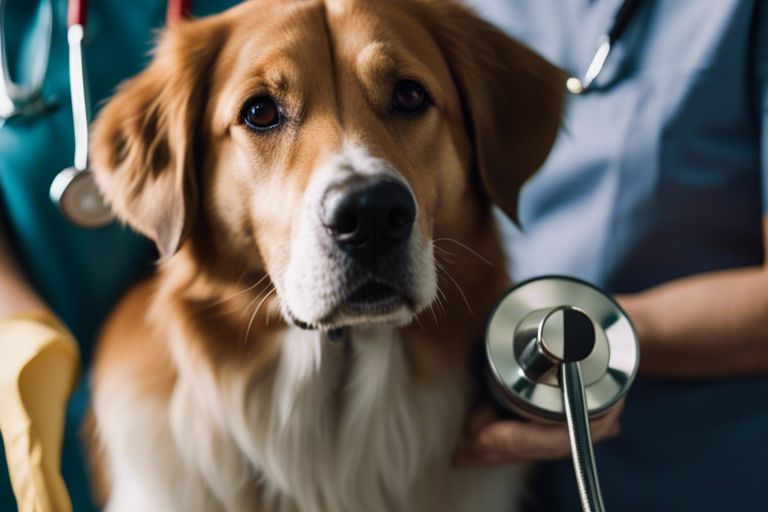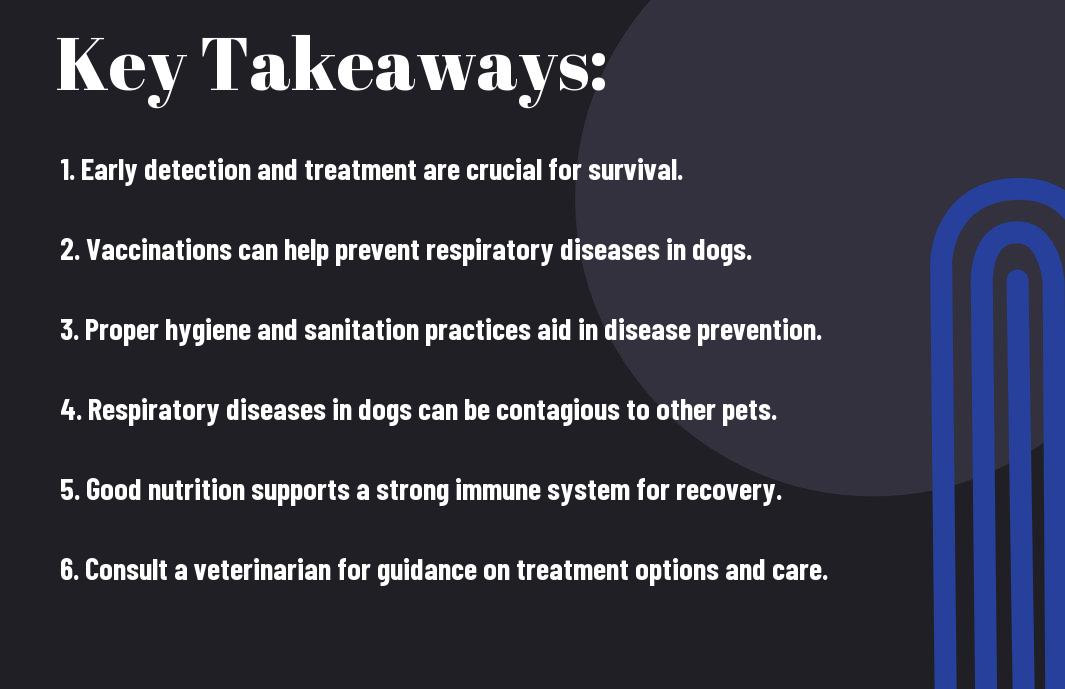Just like humans, dogs can also suffer from respiratory diseases, which can be a cause of concern for pet owners. In this informative blog post, you will learn about the different types of respiratory diseases that can affect dogs, how to recognize the symptoms, and most importantly, what you can do to help your furry friend survive and recover from these conditions. By understanding the signs and seeking proper veterinary care, you can increase the chances of your dog overcoming respiratory diseases and leading a healthy life.
Key Takeaways:
- Early detection: Detecting respiratory disease in dogs early can improve their chances of survival.
- Veterinary care: Prompt veterinary care and treatment are crucial for helping dogs recover from respiratory diseases.
- Maintaining a healthy lifestyle: Providing a healthy diet, regular exercise, and a clean environment can support a dog’s immune system and overall well-being in fighting respiratory diseases.
What is Respiratory Disease in Dogs
While dogs are often seen as active and playful animals, they can also suffer from respiratory diseases that can impact their health and well-being. Understanding what respiratory disease entails in dogs is crucial for proper management and treatment.
Definition and Causes
Respiratory diseases in dogs encompass a range of conditions that affect the lungs, airways, and nasal passages. These diseases can be caused by various factors such as infections (bacterial, viral, or fungal), environmental irritants (pollen, dust, smoke), allergies, anatomical abnormalities, or even cancerous growths.
Common Types of Respiratory Diseases in Dogs
Dogs can be susceptible to various respiratory diseases, with some of the most common ones including:
- Bronchitis: Inflammation of the bronchial tubes.
- Pneumonia: Infection of the lungs that can be caused by bacteria, viruses, or fungi.
- Tracheal collapse: Weakening of the tracheal rings leading to a flattened windpipe.
- Canine influenza: A contagious respiratory infection.
Knowing the signs and symptoms of these respiratory diseases in dogs is necessary for early detection and prompt veterinary care.
| Bronchitis | Inflammation of the bronchial tubes |
| Pneumonia | Infection of the lungs caused by bacteria, viruses, or fungi |
| Tracheal collapse | Weakening of the tracheal rings leading to a flattened windpipe |
| Canine influenza | Contagious respiratory infection |
Symptoms of Respiratory Disease in Dogs
Some respiratory diseases in dogs can present with various symptoms that may indicate a problem with your furry friend’s respiratory system. Two common symptoms to look out for are coughing and wheezing.
Coughing and Wheezing
Symptoms such as coughing and wheezing can be signs of respiratory distress in dogs. If you notice your dog coughing persistently or making wheezing sounds, it could indicate an underlying respiratory infection or condition that requires veterinary attention.
Difficulty Breathing
An indication of respiratory disease in dogs is difficulty breathing. If your dog is breathing rapidly, struggling for breath, or displaying shallow breathing, it is crucial to seek prompt veterinary care. Difficulty breathing can be a serious symptom that requires immediate medical intervention to ensure your dog’s well-being.
It is important to monitor your dog’s breathing patterns regularly to detect any changes that may signify respiratory issues.
Lethargy and Loss of Appetite
Respiratory diseases can also manifest as lethargy and loss of appetite in dogs. If your furry companion is unusually lethargic, showing a lack of interest in food, or experiencing weight loss, it may be linked to an underlying respiratory condition. Veterinary evaluation is necessary to determine the cause and provide appropriate treatment for your dog’s recovery.
Lethargy and loss of appetite are concerning symptoms that should not be ignored, as they can impact your dog’s overall health and quality of life.
Diagnosis of Respiratory Disease in Dogs
Physical Examination
The first step in diagnosing respiratory disease in your dog is a thorough physical examination by a veterinarian. During this examination, the vet will listen to your dog’s lungs and heart, check for any abnormal sounds such as wheezing or crackling, and look for signs of respiratory distress such as increased respiratory rate or effort.
Additionally, the vet may also examine your dog’s nose, throat, and mouth for any signs of infection or obstruction that could be causing respiratory symptoms.
Laboratory Tests
Examination of blood, urine, and respiratory secretions can help in the diagnosis of respiratory diseases in dogs. Blood tests can reveal signs of infection or inflammation, while urine tests can provide information about kidney function and overall health. Respiratory secretions may be collected and analyzed for the presence of bacteria, viruses, or other pathogens.
Furthermore, your vet may recommend more specialized tests such as cultures or sensitivity testing to identify the specific cause of the respiratory disease and determine the most effective treatment.
Imaging Studies
Physical examination and laboratory tests can provide valuable information, but imaging studies such as x-rays or ultrasounds can offer a more detailed look at the internal structures of your dog’s respiratory system. X-rays can help identify abnormalities in the lungs, airways, or heart, while ultrasounds may be used to visualize soft tissues and blood flow.
It is crucial to work closely with your veterinarian to determine the most appropriate diagnostic tools based on your dog’s symptoms and medical history. By combining physical examination, laboratory tests, and imaging studies, your vet can make an accurate diagnosis and develop a comprehensive treatment plan to help your dog recover from respiratory disease.
Treatment Options for Respiratory Disease in Dogs
Now, let’s explore the different treatment options available for respiratory disease in dogs.
Medications
One of the primary ways to manage respiratory disease in dogs is through the use of medications prescribed by your veterinarian. These may include antibiotics to treat infections, bronchodilators to help open up the airways, or anti-inflammatory drugs to reduce inflammation in the respiratory tract.
Oxygen Therapy
One crucial treatment option for severe respiratory disease in dogs is oxygen therapy. This involves providing supplemental oxygen to help your dog breathe more easily and improve their oxygen levels. Oxygen therapy can be administered through a mask, oxygen cage, or nasal prongs, depending on the severity of the condition and your veterinarian’s recommendations.
Understanding the importance of proper oxygenation in respiratory disease is crucial. Lack of oxygen can have serious consequences for your dog’s overall health and well-being. By ensuring they receive adequate oxygen through therapy, you can support their recovery and improve their quality of life.
Lifestyle Changes
One additional way to help manage respiratory disease in dogs is through lifestyle changes. This may include reducing exposure to environmental irritants such as smoke, dust, or strong odors, maintaining a healthy weight to reduce respiratory stress, and ensuring proper ventilation in your home environment.
It is crucial to work closely with your veterinarian to develop a comprehensive treatment plan that may include medications, oxygen therapy, and lifestyle adjustments. By following their recommendations and monitoring your dog’s respiratory health closely, you can help them manage respiratory disease and improve their quality of life.
Management and Care for Dogs with Respiratory Disease
Providing a Comfortable Environment
For your dog with respiratory disease, it’s crucial to provide a comfortable environment that minimizes stress on their respiratory system. Keep your home free of irritants like cigarette smoke, strong scents, and dust. Ensure good ventilation in your home to maintain fresh air circulation. Additionally, consider using a humidifier to help keep the air moist, which can ease breathing for your furry friend.
Nutrition and Hydration
An important aspect of caring for a dog with respiratory disease is ensuring they have a balanced diet that supports their immune system and overall health. Consult your veterinarian for a suitable diet that may include supplements like omega-3 fatty acids or antioxidants. Proper hydration is also key in managing respiratory issues, so make sure your dog has access to fresh water at all times.
Hydration is particularly vital for dogs with respiratory disease as it helps keep their mucous membranes moist and aids in the clearance of mucus from the airways. Encourage your dog to drink water regularly, and consider wetting their food slightly to increase their fluid intake.
Exercise and Activity Levels
On top of a balanced diet and adequate hydration, maintaining appropriate exercise and activity levels is imperative for dogs with respiratory disease. However, it’s crucial to tailor activities to your dog’s condition. Avoid strenuous exercise that could overwork their respiratory system, and opt for gentle walks or play sessions in well-ventilated areas.
Monitoring your dog during physical activity is important to ensure they do not become overly fatigued or experience breathing difficulties. Be attentive to any signs of distress such as excessive panting or wheezing, and adjust their exercise routine accordingly to prevent exacerbating their respiratory symptoms.
Prognosis and Survival Rate of Dogs with Respiratory Disease
Factors Affecting Survival Rate
After diagnosing respiratory disease in your dog, it is crucial to consider various factors that can affect their prognosis and survival rate. These factors include the underlying cause of the respiratory disease, the severity of the condition, the age and overall health of your dog, and how quickly treatment is initiated.
- The underlying cause of the respiratory disease plays a significant role in determining your dog’s prognosis. Some causes, such as pneumonia or cancer, may have a more guarded prognosis compared to others like allergies or asthma.
- The severity of the condition and how well your dog responds to treatment will also impact their survival rate. Dogs with mild respiratory issues may have a better prognosis than those with severe breathing difficulties.
Perceiving these factors can help you and your veterinarian make informed decisions regarding treatment options and the long-term care of your dog.
Average Life Expectancy
Survival rates for dogs with respiratory disease can vary depending on the specific condition and how it is managed. On average, dogs with mild to moderate respiratory issues can live a relatively normal and comfortable life with proper treatment and care. Dogs with more severe or chronic respiratory diseases may have a shorter life expectancy, but this can be prolonged with appropriate management.
Plus, early detection, prompt treatment, and ongoing monitoring can all contribute to a better prognosis and improved life expectancy for your furry companion.
Quality of Life Considerations
The quality of life for a dog with respiratory disease is of utmost importance when considering their long-term prognosis. Managing respiratory symptoms effectively, providing a comfortable environment, ensuring proper nutrition, and maintaining regular veterinary check-ups are important to enhancing your dog’s quality of life.
The emotional and physical well-being of your dog should always be a priority, and making adjustments to their lifestyle and treatment plan as needed can help maintain a good quality of life despite respiratory challenges.
Final Words
Drawing together all the information provided, it is evident that with proper medical intervention and care, dogs can indeed survive respiratory diseases. It is crucial to monitor your dog’s symptoms closely and seek veterinary help promptly if you notice any signs of respiratory distress. Be mindful of, early detection and treatment can greatly increase the chances of a successful recovery for your furry friend. For further insights, you can refer to a study on Successful treatment of acute respiratory distress ….
FAQ
Q: What are the common respiratory diseases in dogs?
A: Common respiratory diseases in dogs include kennel cough, pneumonia, bronchitis, and influenza.
Q: How can respiratory diseases affect a dog’s health?
A: Respiratory diseases can affect a dog’s health by causing symptoms such as coughing, wheezing, difficulty breathing, fatigue, and loss of appetite. In severe cases, respiratory diseases can be life-threatening.
Q: Can dogs survive respiratory diseases?
A: Yes, with prompt veterinary care and treatment, many dogs can survive respiratory diseases. Early diagnosis and appropriate treatment are key factors in a dog’s recovery.
Q: What are the treatment options for dogs with respiratory diseases?
A: Treatment options for dogs with respiratory diseases may include medications such as antibiotics, cough suppressants, bronchodilators, and supportive care such as rest and hydration. In severe cases, hospitalization may be necessary.
Q: How can respiratory diseases in dogs be prevented?
A: Respiratory diseases in dogs can be prevented by ensuring they are up-to-date on vaccinations, avoiding exposure to sick animals, maintaining good hygiene practices, providing a balanced diet, and keeping the environment clean and well-ventilated.
Are strawberries toxic for dogs
Your Dog’s Allergies: Expert Advice
Demystifying Anal Gland Issues in Dogs: Your Comprehensive Guide from the American Kennel Club




